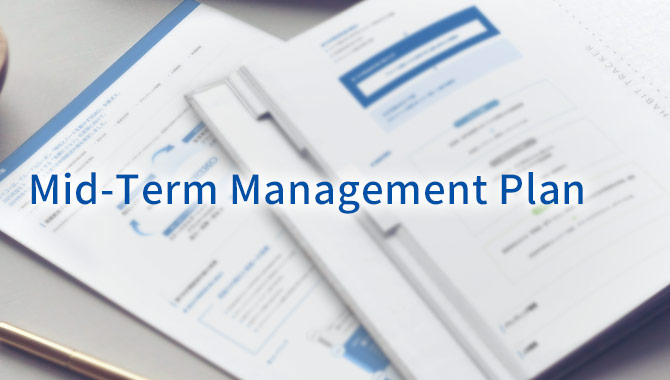Our Group positions “Addressing Climate Change and Decarbonization” as one of our material priorities. We have long-term targets for reducing greenhouse gas emissions, and we are intensifying our efforts towards lowering our Group’s carbon footprint.
Based on the recommendations of the Task Force on Climate-related Financial Disclosures (TCFD), to which we pledged our support in October 2021, we are conducting scenario analysis for our business covering the risks and opportunities related to climate change. At the same time, we are enhancing information disclosure about our initiatives for decarbonization.

Governance
Important matters related to climate change are discussed and resolved by the Sustainability Committee, which was established to facilitate the formulation of the Group's ESG and SDGs policies and activities based on these policies, and are reported to the Board of Directors. The Board of Directors is responsible for the oversight function of the Sustainability Committee and regularly discusses important matters related to climate change.
In addition, the rate of CO2 emissions reduction is included as a “non-financial (ESG) assessment” in the performance evaluation index as a KPI for performance-linked executive compensation.
Promotion Structure


Roles
Board of Directors
The Board will receive reports on the Sustainability Committee’s resolutions at least once a year, and will oversee activities and progress on related issues. Additionally, it will hold regular discussions on matters of significance related to climate change.President(Climate Change Response Supervisor)
Important matters related to climate change are overseen by the President. The President chairs the Sustainability Committee, which is ultimately responsible for formulating the Group's ESG and SDGs policies, including important matters related to climate change, and for making management decisions regarding all activities based on these policies.Sustainability Committee
The Sustainability Committee is chaired by the President, who is in charge of climate change, and consists of full-time officers including the director in charge of ESG/SDGs, representative directors and corporate auditors of each Group company. The committee meets twice a year in principle to discuss and pass resolutions on matters related to the Group's ESG and SDGs materiality, including important matters related to climate change, at extraordinary meetings held as necessary, and reports the resolutions to the Board of Directors. Based on the resolutions made by the Sustainability Committee, the directors in charge take the lead in promoting activities.
Climate-related Board of Directors and Committee Meetings Held
Matters related to the Group’s ESG and SDG materiality, including important matters related to climate change, are in principle discussed and resolved by the Sustainability Committee twice a year, and reported to the Board of Directors at least once a year. Since the establishment of the Sustainability Committee in September 2021, that Committee has been actively discussing issues, adopting resolutions, and reporting to the Board of Directors. The main climate-related matters are as follows:
| Month held | Main climate-related content + output | |
|---|---|---|
| Board of Directors | Nov. 2021 | Establishment of sustainability policy (Resolution) |
| Dec. 2021 | Establishment of long-term targets for reduction of greenhouse gas emissions (Report) | |
| Apr. 2022 | Key actions for materiality (Report) | |
| Jul. 2022 | Information disclosure based on TCFD recommendations (Report) | |
| Nov. 2022 | FY2021 greenhouse gas emissions results (Report) | |
| Feb. 2023 | Information disclosure update based on TCFD recommendations (Report) | |
| Apr. 2023 | Sustainability Report (SDGs Strategy) and Accelerated Plan for the Introduction of Renewable Energy (Report) | |
| Jul. 2023 | 2022 Greenhouse Gas Emissions Performance Report | |
| Nov. 2023 |
Key Actions for Materiality (Including Scope 3 Performance) Report Revision of Long-term Greenhouse Gas Emission Reduction Targets and Decarbonization Transition Plan (Report) |
|
| Sustainability Committee | Oct. 2021 | Key actions regarding materiality (Discussion) |
| Dec. 2021 | Establishment of long-term targets for reduction of greenhouse gas emissions (Discussion and Resolution) | |
| Mar. 2022 | Key actions regarding materiality (Discussion and Resolution) | |
| Jul. 2022 | Information disclosure update based on TCFD recommendations (Discussion and Resolution) | |
| Sep. 2022 | Key actions regarding materiality (Report) | |
| Dec. 2022 | Decarbonization roadmap (including transition plan) (Discussion) | |
| Feb. 2023 | Information disclosure update based on TCFD recommendations (including decarbonization transition plan) (Discussion and Resolution) | |
| Mar. 2023 |
Progress Report on Key Actions for Materiality Discussion and Resolution on the Accelerated Plan for the Introduction of Renewable Energy |
|
| Jun. 2023 | 2022 Greenhouse Gas Emissions Performance Report | |
| Sep. 2023 | Progress Report on Key Actions for Materiality (Including Scope 3 Performance) | |
| Oct. 2023 | Discussion and Resolution on the Revision of Long-term Greenhouse Gas Emission Reduction Targets and Decarbonization Transition Plan |
Performance-Linked Executive Compensation
Compensation for executive directors and corporate officers will consist of a fixed "base salary," a performance-linked "bonus," and additional "stock-based compensation," while compensation for non-executive directors, such as outside directors, will consist of only a base salary. In order to strengthen incentives and ensure the effectiveness of our medium-term management plan, we have set three financial indicators and two non-financial indicators as KPIs for assessing compensation. They are, respectively, consolidated operating profit, consolidated net sales margin, consolidated ROIC, individual evaluation, and ESG indicators (rate of CO2 emissions reduction, etc.). The following table shows the approximate ratios of each type of compensation. (Assuming that 100% of payment is based on measured performance and qualitative evaluation)


Performance-linked Compensation Metrics
| Performance indicators | |
|---|---|
| Bonus | ①Consolidated operating profit |
| ②Consolidated net sales margin | |
| ③Individual performance evaluation | |
| Stock-based compensation | ①Consolidated operating profit |
| ②Consolidated net sales margin | |
| ③Consolidated ROIC | |
| ④ESG assessment: CO2emissions reduction rate (SCOPE1,2), etc. |
Strategy
Scenario analysis process
In order to assess the financial and business impact of climate-related risks and opportunities on our Group under different scenarios and to enhance our Group's resilience, we conduct scenario analysis according to the following steps.
Reference Scenario
| Classification | Scenario Overview | Main Reference Scenario |
|---|---|---|
| Less than 2℃ Scenario | A scenario in which policies and regulations are implemented to achieve a decarbonized society and the global temperature increase from pre-industrial times is limited to less than 2℃. Transition risk is high, but physical risk is lower than in the 4℃ scenario. | ・IEA World Energy Outlook 2022. Announced Pledges Scenario ・IPCC RCP2.6/SSP1-2.6 |
| 4℃ Scenario | A scenario in which no new policies or regulations are introduced and global energy-derived CO2 emissions increase continuously; compared to the less than 2℃ scenario, the transition risk is lower, but the physical risk is higher. | ・IEA World Energy Outlook 2022. Stated Policy Scenario ・IPCC RCP8.5/SSP5-8.5 |
Scenario Analysis Steps
-
STEP 1 Identification of significant climate-related risks/
opportunities and establishment of parameters- Identify climate-related risks and opportunities
- Assess high significance risks/opportunities
- Set parameters related to highly significant risks/opportunities
-
STEP 2 Setting climate-related scenarios
- Based on the information in STEP 1, etc., identify scenarios that are closely related to the existing scenarios
- Establish climate-related scenarios (social vision)
-
STEP 3 Assessment of financial
impact for each scenario- Analyze the financial impact of each scenario based on the scenarios established in STEP 2 and the key climate-related risks/opportunities and related parameters identified in STEP 1
-
STEP 4 Assessment of the resilience of the strategy to climate-related risks and opportunities and further measures to address them
- Assess the resilience of our strategy to climate-related risks and opportunities
- Consider further response measures
Business impact associated with climate-related risks and opportunities and the Group's response
We have conducted scenario analysis covering all Group businesses, and assessed key risks and opportunities. Based on this review, we are formulating and implementing measures to address these risks.
Climate-related risk
| Risk category | Risk description | Business impact (2030)*1 | Our Group's response | |||
|---|---|---|---|---|---|---|
| Less than 2℃ scenario | 4℃ Scenario | |||||
| Risk | Transition risk | Policy & regulation | Increased costs due to introduction and strengthening of carbon tax | 450 million yen*2 Medium |
350 million yen*2 Medium |
|
| Technology | Increased manufacturing and transportation costs due to higher energy prices | Medium | Medium | |||
| Market | Decreased sales due to inability to respond to requests from suppliers for climate-related measures | Medium | Medium |
|
||
| Increased procurement costs due to higher raw material prices | Medium | Medium |
|
|||
| Physical risk | Urgent | Decreased sales due to supply chain disruptions and distribution delays caused by extreme weather conditions | Small | Medium |
|
|
| Decreased sales due to interruption of factory and/or store operations and difficulty in securing personnel due to extreme weather conditions | Medium | Large | ||||
| Chronic | Rising loss premiums due to increase in extreme weather conditions | Medium | Medium | |||
Climate-related opportunities
| Opportunity category | Opportunity description | Business impact (2030) *1 | Our Group's response | ||
|---|---|---|---|---|---|
| Less than 2℃ scenario | 4℃ scenario | ||||
| Opportunity | Energy source | Cost reduction by introducing renewable energy | Medium | Medium |
|
| Products and services | Increased sales of low-power- consumption compatible products due to expansion of CPS/IoT society | Medium | Medium |
|
|
| Increased sales of related parts to automobile sector due to ongoing shift to EVs | Medium | Medium |
|
||
| Increased sales of low-carbon products and services that can help customers reduce their environmental impact | Large | Large |
|
||
| Increased sales of products that respond to consumers' growing environmental awareness | Small | Small |
|
||
| Market | Creation of new products & services related to IoT, manufacturing, and distribution that will accompany the promotion of energy conservation | Medium | Medium |
|
|
| Increased sales due to improved brand value through decarbonized management | Medium | Small |
|
||
-
- *1
- Large business impact: Extremely significant impact on business, such as an impact on profits of 1 billion yen or more, withdrawal from a business, or an interruption of business for several months or more.
Medium business impact: Significant impact on business, such as a profit impact of between 100 million yen and 1 billion yen, negative impact on business plans, downsizing of a business, or a business interruption of one week to one month.
Small business impact: Minor or negligible impact on business, such as a profit impact of less than 100 million yen, little or no impact on business plans, or little or no interruption of business.
-
- *2
- We calculated the 2030 greenhouse gas (GHG) emissions (Scope 1, 2) based on growth forecasts and reduction plans. The calculations were done by multiplying the IEA forecasted carbon prices for both the less-than-2°C and 4°C scenarios. We used an exchange rate of 1$ = 140 JPY.
Risk Management
The Seiko Group Risk Management Committee, chaired by our President, is tasked with centrally managing risks that significantly impact the Group’s business. Important risks that require Group-wide attention are defined as Group Critical Risks. The Committee evaluates these risks annually based on factors such as their likelihood of occurrence and projected impact on Group business, then selects the most critical items for attention.
The Committee also receives reports on responses to Group Critical Risks and the progress of those responses from risk owners within each Group company. The Committee monitors risk responses and reports to the Board of Directors. Additionally, there is a Group Risk Management Committee consisting of full-time officers and representatives of each Group company. This committee provides a framework to identify and share risks across the entire Group.
The Sustainability Committee uses scenario analysis to identify and evaluate particularly impactful climate-related risks for each Group company. The Committee then passes resolutions and promotes optimal responses to these risks across the Group. As noted before, the resolutions are reported to the Board of Directors. Climate-related risks are included among Group Critical Risks, and the response measures and progress in executing them are reported to the Seiko Group Risk Management Committee by the responsible officers.
Group Risk Management Promotion Structure


Roles
Seiko Group Risk Management Committee *1
Chaired by the President, the Seiko Group Risk Management Committee focuses on risks that need to be addressed across the Group. The Committee also receives reports from risk owners at the Company and at Group companies, and supports the promotion of risk management at each company.Group Risk Management Committee *2
Consisting of full-time officers and representative directors from Group companies, the Group Risk Management Committee confirms and shares information about Group-wide risks, and for critical risks, it also monitors and shares information about risk responses.Risk Management Committee of Each Group Company *3
Each Group company promotes risk management autonomously, led by its own Risk Management Committee.Sustainability Committee
The Sustainability Committee holds discussions and makes resolutions on matters related to the Group's ESG and SDGs materiality, including climate-related risks, and reports the resolutions to the Board of Directors. For climate-related risks that have been selected as Critical Risks for the Group, the Committee reports to the Seiko Group Risk Management Committee through the director in charge regarding specific responses and the Group’s progress in enacting those responses.
Indicators and Targets
In November 2023, the Seiko Group revised its long-term targets to expedite the reduction of greenhouse gas emissions. In line with this long-term goal, we will continue to accelerate our adoption of renewable energy and make efforts to further reduce greenhouse gas emissions.
Regarding our targets for fiscal year 2030, we have obtained certification from the Science Based Targets initiative (SBTi), confirming that our targets align with the 1.5°C target set out in the Paris Agreement.
Long-Term Targets for Greenhouse Gas Emissions Reduction
Greenhouse gas emissions reduction target
Fiscal Year 2030
Scope1, 242% reduction compared to the FY2022 level.
Scope325% reduction compared to the FY2022 level, targeting categories 1 and 11.
Fiscal year 2050
Aiming for net zero.
Decarbonization Transition Plan (Scope 1, 2)
In November 2023, the Seiko Group revised its decarbonization roadmap to align it with our updated long-term targets for reducing greenhouse gas emissions. The Group continues to make progress in energy efficiency by updating existing facilities with energy-efficient equipment, enhancing productivity, and by investigating, developing, and implementing energy-efficient manufacturing methods and devices.
In terms of adopting renewable energy, we prioritize facility introduction, and we are accelerating plans to switch to renewable energy at each site. The goal is to achieve 100% renewable energy at domestic sites by the end of FY2024 and at all sites, including overseas, by the end of FY2040. The Group aims to switch from fossil fuels to decarbonized or low-carbon alternative fuels. The residual emissions will be offset through the introduction of removal credits, with the aim of achieving net-zero emissions by fiscal year 2050.

Scope 1, 2 GHG Emissions (t-CO2)
Performance from Fiscal Year 2019 to 2023
In FY2023, our greenhouse gas emissions amounted to 79,941 t-CO2, achieving a reduction of 17.2% compared to FY2022. This surpassed our target of 5.25%, which is the amount necessary to achieve our long-term target.* This achievement was largely due to ongoing energy-saving activities and the introduction of renewable energy.The ratio of renewable energy power reached 18.9%.
*In November 2023, we revised our long-term goals. Previously, the goal was to reduce by 42% compared to 2020 by 2030. After the revision, the goal is to reduce by 42% compared to 2022 by the fiscal year 2030, setting a higher target.


Scope 1: Direct emissions from sources that are owned or controlled by the organization (e.g., fuel combustion).
Scope 2: Indirect emissions from the generation of purchased electricity, steam, heating, or cooling consumed by the organization, which are associated with an electricity market-based accounting method.
*Due to rounding, the total value of GHG emissions and breakdown may not match.
*The CO2 emissions figures for fiscal years before 2019 have been retroactively recalculated due to a revision in CO2 emissions factors.
*There are no emissions from biogenic sources.
-
- Note 1:
- Emission factors
-
- Electricity:
- For Japan, the adjusted emission factors of emission factor by electric utility specified by the Law Concerning the Promotion of the Measures to Cope with Global Warming is used.
For overseas, IEA (International Energy Agency) emission factors for each country are used
-
- Fuel:
- Both for Japan and overseas, the calorific value by fuel type and emission factor for fuel use specified by the Law Concerning the Promotion of the Measures to Cope with Global Warming are used.
However, if information such as calorific value is provided by the suppliers, it is used.
-
- Chilled/heated water:
- Emission factors provided by suppliers are used.
-
- Note 2:
- Starting in FY2020, tenants, stores, warehouses, etc. have been added to the scope of calculation. Company vehicles are included, but energy use by outsourcing is not included.
-
- Note 3:
- For stores, warehouses, etc., where the amount of electricity used cannot be specified, the amount of electricity is estimated from the floor space.
-
- Note 4:
- Domestic facilities include 6.5 gas. Overseas facilities include only CO2 deriving from energy use.
Scope 3 GHG Emissions (t-CO2) Performance for the Fiscal Year 2023
The Scope 3 emissions amounted to 555,178 t-CO2. Among the categories, the purchase of products and services (Category 1) accounted for approximately 66%, and the use of sold products (Category 11) constituted around 13%, ranking as the top contributors to Scope 3 emissions.
| Category | Item | GHG emissions (t-CO2) |
% |
|---|---|---|---|
| Category 1 | Purchased goods and services | 367,709 | 66.2% |
| Category 2 | Capital goods | 36,082 | 6.5% |
| Category 3 | Fuel- and energy-related activities not included in Scope 1 or Scope 2 | 12,399 | 2.2% |
| Category 4 | Upstream transportation and distribution | 34,037 | 6.1% |
| Category 5 | Waste generated in operations | 2,464 | 0.4% |
| Category 6 | Business travel | 4,508 | 0.8% |
| Category 7 | Employee commuting | 5,483 | 1.0% |
| Category 8 | Upstream leased assets | 122 | 0.0% |
| Category 9 | Downstream transportation and distribution | 3,476 | 0.6% |
| Category 10 | Processing of sold products | 12,469 | 2.2% |
| Category 11 | Use of sold products | 71,111 | 12.8% |
| Category 12 | End-of-life treatment of sold products | 4,610 | 0.8% |
| Category 13 | Downstream leased assets | 708 | 0.1% |
| Category 14 | Franchises | - | - |
| Category 15 | Investments | - | - |
| total | 555,178 | 100.0% |
*The total amount may not match due to the processing of fractions.

















